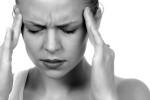A monthly Health and Welness article from our parish nurse.
That headache just might be a migraine. Migraine headache is defined as a headache that lasts up to 72 hours when left untreated. It is a significant health concern in this country. Women are three times more likely to experience migraine headache than men, and it is estimated that over 18% of American women suffer from this condition. People who experience migraines feel intense physical pain which is often accompanied by nausea, vomiting, blurred vision and feelings of complete disability. This type of headache is usually limited to one side of the head, produces moderate or severe pain aggravated by physical activity. Often it is accompanied by sensitivity to light and some may experience an aura (loss of vision) before or during the migraine headache attack. This has also been called a “sick headache”. Migraine headaches tend to first appear between the ages of 10 and 45 and seem to run in families.
Although the cause of this painful headache is not known, it seems to be initiated by environmental triggers such as changes in weather, psychosocial stress (especially during vacations or holidays), hormonal triggers and ingested substances which may include monosodium glutamate, caffeine, aspartame, chocolate and alcohol. Sometimes this is caused by stress and frequently by a change in weather.
There is documentation that migraine headaches have occurred for thousands of years. Migraine headache is a chronic illness and persons who suffer from it have a lower quality of life and a higher incidence of depression. Many of the sufferers believe that others judge them for missing work and taking medications. They must adjust their lifestyle in an effort to manage their illness. Often they have feelings of vulnerability and helplessness and can’t focus.
Migraine headache impacts relationships and diminish the person’s ability to concentrate. Often the sufferer is driven to bed with darken windows to block out the light. After the pain subsides, there is a feeling of fatigue and weakness. There is little or no appetite. Vision disturbances, or aura, are considered a "warning sign" that a migraine is coming. The aura occurs in both eyes and may involve a temporary blind spot, blurred vision, eye pain, tunnel vision, seeing stars or wavy lines or any combination.
True migraine headaches are not the result of a brain tumor but are caused by abnormal brain activity. The chain of events triggering them, are unclear. Most medical experts believe the attack starts in the brain, affects changes in the brain blood flow and involves nerve pathways and chemicals. Only an experienced health care provider can determine whether the symptoms are due to a migraine or another condition so a self diagnosis is not advisable. Your doctor can diagnose this type of headache by asking questions about your symptoms and family history of migraines. A complete physical exam will be done to determine if your headaches are due to muscle tension, sinus problems, or a serious brain disorder. There is no specific test to prove that your headache is actually a migraine although once you’ve had one, you have little trouble recognizing the next one. If your symptoms include weakness, memory problems or loss of alertness with your migraine, your doctor may order a brain MRI or CT scan if you have never had one before. An EEG may be needed to rule out seizures. A lumbar puncture (spinal tap) might be done.
Because there is no specific cure for migraine headaches, the goal is to treat the symptoms as soon as possible. It’s best to prevent symptoms by avoiding your triggers if known. A key step involves learning how to manage your migraines at home. A headache diary can help you identify your triggers and occurrences. Medications can help reduce the frequency and severity of migraines so if your medication hasn't worked for you in the past, talk to your doctor about trying a different one. The right medicines can make a huge difference when combined with self-help remedies and lifestyle changes. Some women, but not all, may have fewer migraines when they are pregnant. People with migraines should avoid other risk factors for stroke, including smoking, taking birth control pills, and eating an unhealthy diet. Support Groups for migraine sufferers include: American Council for Headache Education - www.achenet.org The National Migraine Association - www.migraines.org National Headache Foundation - www.headaches.org




Comments
Login/Register to leave a comment